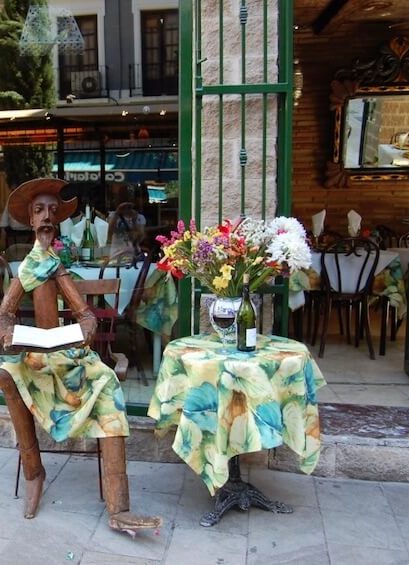Lunch in Spain
Explaining one of the world’s most unique culinary traditions.
August 2, 2021

Lunch in Spain is the dominant backdrop to life.
Ironically, the actual word for lunch in Spanish, “almuerzo,” is possibly the most useless in the lexicon, because it is invariably replaced by “comida” which is simply, food. If you say, “let’s meet for food/to eat,” you mean, “let’s meet for lunch.”
Late, lavish and lingering
The Spanish lunch is late, lavish and lingering. On special occasions, like Friday- because-the-weekend-starts-tomorrow, it is epic and epicurean.
It can begin at 3:00pm and last until, well, dinner time. Almuerzo/comida often features a three-course menú del dia (menu of the day), wine, and sobremesa.
Sobremesa
There is no English equivalent for sobremesa, which would literally translate as “on the table.”
What it refers to are the long hours spent sitting around the table after the food has been eaten, shooting the breeze, quaffing coffees that might lead to gin and tonics, because by this time it is often 6:00pm and so, why not?
Investigating the origins
Staring lunch at three and ending it at past six in the evening is such a distinctive custom, that it requires anthropological investigation. How did “the Spaniard” evolve to behave thus?
The answer is complex and involves: personality, Franco and longitudinal mismatch.
Personality
The personality bit is well-known.
The Spaniard is an easy-going character, who likes to spend time with friends and family, enjoys the good things in life and leans more heavily on the life end of work-life balance.
Franco and the menu del día
Dispensing with the 19th century racist taxonomy, we move on to Franco.
Francisco Franco was the military dictator who reigned over Spain between 1935 and 1975. The menú del día of today – the culprit of many lengthy lunches – dates to legislation in the mid-1960s that aimed to kill two birds with one stone: placating workers and attracting tourism.
In 1965, the government implemented a law requiring restaurants across the country to provide a hearty and affordable lunch for workers who could not make it back home for a wife-cooked meal.
Tourism boom
Spain was also in the midst of a tourist boom at the time. It had gone from playing host to 2.9 million tourists in 1959, to over 11 million visitors in 1965.
It was thought that tourists might appreciate some value for money at lunch, too. Enter the menú turístico. This was was essentially the same idea as the menú del día.
New regulations obliged all restaurants to offer a three-course lunch option that included items from the à la carte menu and encouraged cooks to shop at their local food markets for ingredients. It was also required that the price of the menu did not exceed 80% of the cost of ordering each dish individually.
Value for money
Today, it is no longer compulsory for restaurants to offer a menú del día, nor is the price of the menus controlled by law.
It does, however, remain a fairly common practice. It can be quite irresistible to be able to choose from three starters, three mains, a dessert and coffee for an average of about 12 Euros.
Longitudinal mismatch
The length of the Spanish lunch is well explained by the conviviality of the Spanish people, the custom of sobremesa and the vast quantities of food at affordable prices represented by the menú del día.
But what accounts for the strangest of all facets of Spanish life and lunch? The uniquely late timing?
This is the bit about longitudinal mismatch and it also involves the Generalissimo’s heavy hand.
Franco, again
In 1940, Franco moved Spain’s clocks ahead by one hour, so as to be at the same time as Nazi Germany. Autocrats like to be in sync. Spain may have transitioned to a democracy, but its time zone is a relic of its authoritarian past.
It still runs on Central European Time, when it should really be on Greenwich Mean Time, like the United Kingdom. In fact, Madrid should be in a time zone even further behind the U.K.’s given its longitude, which is well to the west of London.
Clock vs natural time
This time-zone confusion means that 3:00pm clock-time in Madrid is actually closer to 1:00pm “natural” time. This makes the late lunch hour far more comprehensible.
Spaniards eat according to the “natural” time of the day, even as they follow the clock for most other schedules like school and office timings.
And there you have it: the logical explanation for the mystery that has befuddled generations of travelers to Spain: lunch at 3:00pm (in fact 1:00pm) and dinner at 10:00pm (in fact 8:00pm).
You are welcome!
Takeaways
The Spanish lunch is late, lavish and lingering. On special occasions, like Friday- because-the-weekend-starts-tomorrow, it is epic and epicurean.
There is no English equivalent for the term, sobremesa, which literally translates as “on the table.” It refers to the long hours spent sitting around the table after the food has been eaten.
The evolution of the Spanish lunch is the result of three main factors: personality, Franco and longitudinal mismatch.
In 1965, the Spanish government implemented a law requiring all restaurants to provide a hearty and affordable lunch for workers who could not make it back home for a wife-cooked meal.
Spain may have transitioned to a democracy, but its time zone is a relic of its authoritarian past. This explains the late hour of lunch.

